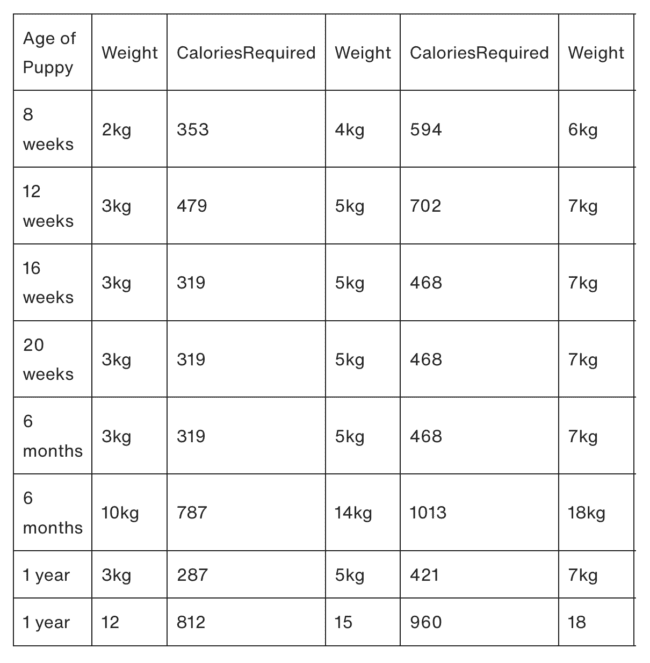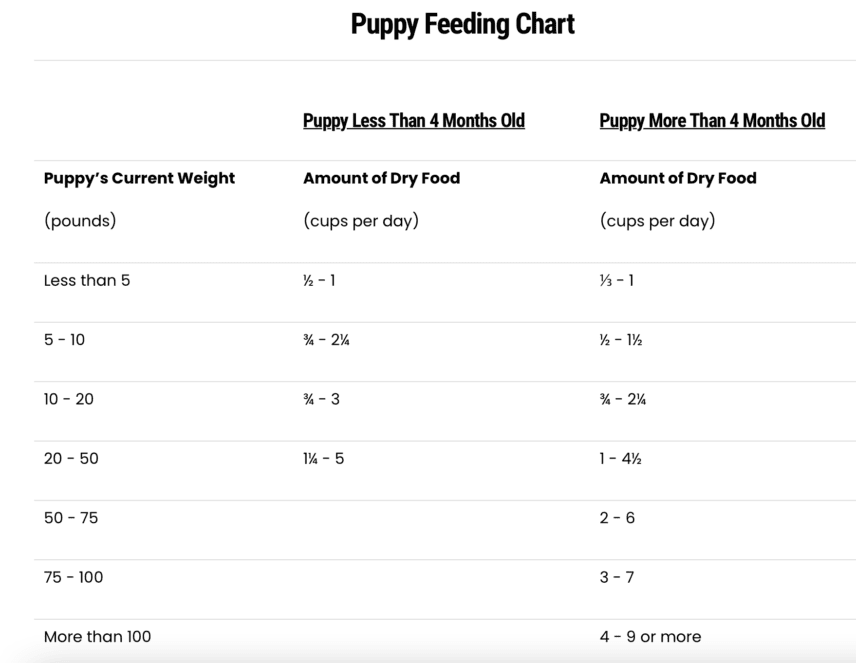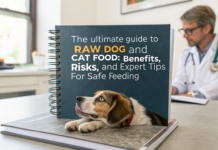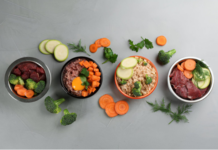Last Updated on September 29, 2023 by Dogs Vets
How Much to Feed a Puppy by Weight (in Kilograms)
When it comes to your furry companion’s health, providing the right nutrition is paramount.
A common question among puppy owners is, “How much should I feed my puppy by weight in kilograms?”
In this comprehensive guide, we’ll address this query and equip you with the knowledge to ensure your puppy’s healthy growth.
Understanding Your Puppy’s Needs
Before we delve into specific feeding guidelines, it’s essential to recognize that puppies have unique dietary requirements compared to adult dogs.

Their rapid growth and development demand a well-balanced diet to support their energy levels, muscle growth, and overall health.
Feeding by Weight: A Tailored Approach
The ideal amount of food your puppy needs varies based on their weight in kilograms. Here’s a breakdown to help you determine the appropriate feeding portions:
Puppies Under 5 kg
For smaller breeds weighing less than 5 kg, it’s advisable to start with 30-50 grams of high-quality puppy food per kilogram of body weight. Gradually adjust as your puppy grows.
Puppies Between 5-10 kg
Puppies weighing between 5 to 10 kg may require 20-30 grams of food per kilogram of body weight. Monitor their growth and adjust accordingly.
Puppies Over 10 kg
Larger breeds over 10 kg might need around 15-25 grams of food per kilogram of body weight. Remember that individual puppy metabolism and activity levels can influence these numbers.
The Importance of Monitoring
While these guidelines provide a starting point, it’s crucial to closely observe your puppy’s weight, energy levels, and overall health. Adjust their diet as needed to maintain a healthy weight.
How to Determine the Right Puppy Diet
Are you wondering about the best way to feed your beloved puppy? Well, grab a cup of your favorite beverage, sit back, and let’s explore the factors that determine how much to feed your puppy.

Feeding your furry friend is more than just providing sustenance; it’s about ensuring their growth, energy levels, and overall well-being.
Factors to Consider
Determining your puppy’s ideal diet involves considering several key factors:
1. Age
The age of your puppy plays a crucial role in their dietary needs. Young puppies have different nutritional requirements compared to adult dogs.
2. Breed
Different dog breeds have varying metabolism rates and growth patterns, which impact their dietary needs.
3. Weight
Your puppy’s current and expected weight are important factors to consider when planning their diet. It ensures they receive the right amount of calories for their size.
4. Activity Level
Is your puppy a spirited Cocker Spaniel or a mellow St. Bernard? Their activity level affects how many calories they require daily.
5. Type of Food
Consider whether you’re feeding your puppy wet, dry, or raw food, as each type has distinct nutritional qualities.
By taking these factors into account, you can determine the correct calorie intake for your puppy. Additionally, you should assess the nutritional content of the food you’re currently providing.
Premium vs. Cheaper Dog Foods
Let’s compare premium and cheaper dog foods:
Premium Foods
- Higher calorific content.
- Nutrient-dense, containing calcium, magnesium, iron, zinc, and vitamin D for strong teeth and bones.
- Better quality protein sources to keep puppies feeling full.
- Smaller portions required due to higher nutrient density, resulting in smaller stools.
Cheaper Foods
- Lower quality protein sources.
- More empty fillers designed to keep puppies feeling full.
- Larger portions needed to ensure adequate nutrient intake, leading to larger stools.
In summary, opting for premium dog food offers better digestibility, nutrient absorption, and smaller clean-up duties. It’s a win-win for both you and your puppy.
Breed, Age, and Weight Considerations
Large vs. Small Breeds
Interestingly, larger breeds need fewer calories per kilogram of body weight compared to smaller breeds. This means small breeds may require as much as twice as many calories for their body weight.
For instance, Jack Russell Terriers, a small breed, have a faster growth rate and mature at around 12 months. In contrast, large breeds like Great Danes grow more slowly and don’t reach maturity until around 2 years old.
Large Breed Puppy Food
Large breed puppies need lower-calorie density food to promote gradual growth. They won’t reach their full adult weight until around 2 years old.
Addressing Specific Breeds
Labrador Retriever
Labradors are notorious for their seemingly insatiable appetite. Large breed puppy food with lower calorie density is recommended to encourage controlled growth.
Cocker Spaniel
Cocker Spaniels, being medium-sized dogs, can be fed regular puppy food. They reach full adult weight at around a year old.
Border Collie
Border Collies belong to the pastoral group and reach adult weight by 12-15 months. They maintain their playful puppy behavior for longer, so be mindful of their energy levels.
Chihuahua
Chihuahuas are tiny dogs that reach adult weight by 10-12 months. Due to their size, be cautious not to overfeed them; small, frequent meals may work best.
Beagle
Beagles are medium-sized and can be fed regular puppy food. Be mindful of their lean physique, and adjust their diet as needed.
Frequently Asked Questions
1. How does raw food work for puppies?
- On average, feed a healthy puppy 5-8% of their body weight per day. Adjust based on their activity levels.
2. Wet vs. dry food – how much of each should I feed my puppy?
- Generally, you’ll need to feed approximately double the amount of wet food compared to dry food due to differences in moisture content.
3. Can puppies eat the same food as adult dogs?
- While they can, puppies have different nutritional needs to support growth. It’s advisable to feed them puppy-specific food.
4. What should I feed my puppy in the first year?
- A complete puppy diet is recommended until around a year old. Larger breeds may stay on puppy food longer.
5. How often should dogs eat?
- Establish a mealtime routine for your puppy; it’s better for their metabolism. Young puppies may need up to 4 meals a day, gradually reducing to 3.
6. How can I tell if I’ve overfed my puppy?
- Watch for changes in body condition and increased frequency of bowel movements. Overfeeding can lead to excessive weight gain and runny stools.
7. Should I be able to see or feel my puppy’s ribs?
- You should be able to feel your puppy’s ribs and, depending on their breed, possibly see the bottom two ribs. A healthy balance of fat is ideal.
In conclusion, determining the right diet for your puppy involves careful consideration of their age, breed, weight, and activity level. By tailoring their food to these factors, you’ll ensure your furry friend grows up healthy and happy.
Sources: zigzag.dog
Fact Check
We strive to provide the latest valuable information for pet lovers with accuracy and fairness. If you would like to add to this post or advertise with us, don’t hesitate reach us. If you see something that doesn’t look right, contact us!
Disclaimer: This article is for informational purposes only and should not replace professional veterinary advice.

















